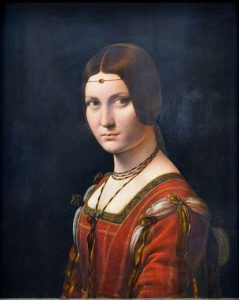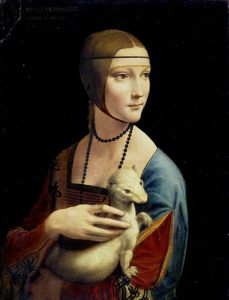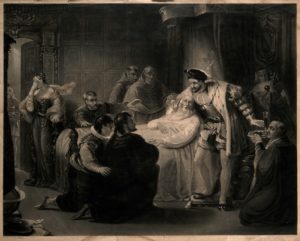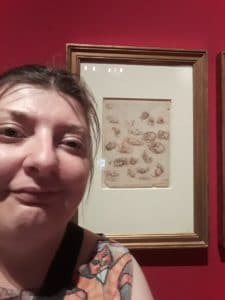 Thank you to author and historical researcher Amanda Harvey Purse for sharing this Boleyn-related article with us today. Over to Amanda…
Thank you to author and historical researcher Amanda Harvey Purse for sharing this Boleyn-related article with us today. Over to Amanda…
It is true to say that over the years of studying the history of art, my love for Leonardo da Vinci’s work has outshone my love for many other artists. As da Vinci was not his surname, but the place in which he was born, out of respect, I will be calling the great artist by his first name within this article. Although I have just called him a great artist, Leonardo was a true Renaissance man for the Medieval and Tudor period. Being only five years older than Henry VII, Leonardo lived through times of war and unrest too, while becoming a master of most trades as he made discoveries in civil engineering, anatomy, geology and hydrodynamics as well as many other subjects; however, it is perhaps when Leonardo turned his hand to paint, that he became a household name from the Tudor period until now.
It may well be hard to imagine Leonardo within the same period as King Henry VII and his son, much like when we think of Westerns films or Sitting Bull and Colonel Custer living at the same time as the Industrial Revolution and Queen Victoria, something may seem to jar a little with these thoughts with us at first; however, Leonardo was indeed a part of the Tudor period, painting his way through the cities of Milan, Florence, Rome and Paris, to name but a few.
Although much of his artwork interests me, two pieces stand out a little more than the rest. These are not the most known of his works – in this modern day, it will not be so easy to find these works on a magnet or novelty mobile phone cover, for example. However, to me, these paintings have the ability to enchant, all the same. These are La Belle Ferronnière and Lady with an Ermine, the latter being a lady holding a white stoat and it has been suggested that the model for this painting was the mistress of Leonardo’s employer, Ludovico Sforza.
To try to understand why the latter painting interests me, I researched it. One of the many things I like about Leonardo’s work is all the suggested codes and symbols he has been said to have added to his artwork, a popular activity for the time, as many portraits of the Tudor monarchs also show us. The Lady with an Ermine is no exception, as the white stoat, for example, was a symbol of purity because it was said that the animal would rather face death than soil its clean, white coat. Was Leonardo suggesting that the model was actually to him a symbol of innocence? We will probably never know his true intention; however, the question of it, the debate of it, fascinates me.

I believe this painting fascinates me for two other reasons. The first is that the model does not look straight ahead at the viewer, nor does she look sideways on. The model, uniquely, is turned in such a way that she appears to be rotating to a third, invisible person in the room. I have always wondered who this person could have been. The second reason is that, if you look closely at the painting, you can see where Leonardo used his fingers to blend paints to have his art the way he wanted it. In fact, when testing was done in later years, Leonardo’s fingerprints could be clearly seen in certain areas. A piece of the great artist, left in the paint for all time, for us future generations to see. I don’t know if many would agree with me, but I think there is something uniquely special in that.
However, it is the other painting I mentioned at the beginning of this piece that I wish to focus on for this article. La Belle Ferronnière is an interesting painting, if often underrated. It may not have the fame of the Mona Lisa or The Last Supper, but still, she captivates anyone that is lucky enough to see her in person, or even when they come across her in a book – that is the power this woman holds.
I do not think I am the only one to feel this way, because in the 2006 Columbia Pictures film The Da Vinci Code, the beginning scenes show the Paris Louvre curator running through the museum as he plans how to leave clues for the main character. As he does this, we, as the viewer, are given flashing images of artwork that the Louvre owns. The flashes focus on the faces within these paintings, to make it look as if they are also witnessing this event with us. One of the pieces of art that flashes up is La Belle Ferronnière and perhaps, more importantly, the camera focuses on her eyes.
I do see what the film was trying to portray in this one moment, a film that mainly and famously concentrates on the Mona Lisa to represent its story, still has a moment for La Belle Ferronnière. Could this suggest that although the Mona Lisa is agreeable, that she is powerful, – she certainly looks at you from any corner of the room she is placed in within the Louvre – but that Leonardo’s brilliance was not confined to just one piece of art, that it is in every piece? The film’s focus on her eyes certainly mirrors the fondness I have for her eyes. For years, I have tried to understand why this painting makes me stop in my tracks to look at her. I have tried to find out why I am always in awe whenever I see it. Was it simply because it was painted in the 15th century by Leonardo? Or was it something more than that?


I had thought once that it might be the mystery this piece holds. For one thing, it has now been discussed whether this portrait was painted by Leonardo in its entirety, or whether it was a joint project within a studio. Some feel that the model appears to be a little more rigid than other models depicted in Leonardo’s work. Also, the model herself is a mystery. She remains unknown, debated up to this very day, so maybe this painting fascinated me because I wanted to know who she was. So with that in mind, I began researching her, and I was shocked to find that a famous Tudor person had been suggested as the model…
In the 18th century, it was suggested that a record had been made at the Louvre Paris Museum describing this painting. Someone named du Rameau, of the Hotel of the Surintendence, wrote: “This lady is dressed in a red bodice, with sleeves of the same colour, attached with green cords; her hair is dressed short and smooth; her collar is trimmed with a cord; she holds a piece of mesh lace and her forehead is encircled by a black cord with a diamond in the centre.” All very descriptive, but it is in his last few words that we have an identity for the model, for du Rameau wrote that the portrait was of “Anne Boleyn” and he went on to declare it to be in “good condition” (D. R.).
Could this be really be true? Could the famous artist, Leonardo, have once painted Anne Boleyn, a past Queen of England? To get somewhere close to answering this most extraordinary of questions, maybe we should first ask, if it was possible that Leonardo and Anne Boleyn met within their lifetimes?
It is recorded that Anne Boleyn spent seven years at the French court, serving Mary, Queen of France, then Queen Claude, the wife of François I, and perhaps the king’s sister, Marguerite of Angoulême. Seigneur de Brantôme even writes in his Lives of Fair and Gallant Ladies, that Anne was “the fairest and most bewitching of all the lovely dames” while she was at the French court.
In 1515, King François I of France won the Battle of Marignano in Italy as he tried to gain control of Milan. While there, the king was said to have seen Leonardo’s fresco of The Last Supper. Being in awe of this masterpiece, the king was then introduced to the artist and offered him the position of First Painter, Engineer and Architect to the King. Leonardo accepted the position, making his way to France, taking with him many of his works, including the now famous Mona Lisa.
A year later, Leonardo was still within the king’s pay and living at the Manoir of Cloux, near the Château of Amboise. This was previously the residence of the king’s sister, Marguerite, and the king was said to have visited the painter there, while, to repay the friendship, Leonardo was said to have appeared occasionally at the French court. As Leonardo’s time at the French court corresponds to Anne Boleyn’s time there, it has been suggested that Anne Boleyn might have known or, at the very least, have come into contact with the famous Leonardo during her time in France.
So there is a possibility of them having known each other, but did she sit for one of Leonardo’s paintings?
Sadly, it seems as if the answer may well be a ‘no’, or at least no to her being La Belle Ferronnière. Although a previous owner of La Belle Ferronnière in the 1920s believed it to be a painting of Anne Boleyn, and went to great lengths to try and sell it as such – but failing and it leading to a lawsuit – it is thought that the portrait was painted between the years of 1490 and 1496, many years before the suggested birth of Anne Boleyn.
So the sitter of La Belle Ferronnière remains a mystery. However, the way in which she was painted, and the genius behind this lesser-known masterpiece, will no doubt still intrigue us for many more years to come. Whether you want to believe it is Anne Boleyn, or not, this suggestion, this loose connection to the Boleyn family, only adds to the energy this painting holds for me.

Amanda Harvey Purse is the author of the award-winning Martha, Inspector Reid: The Real Ripper Street, The Cutbush Connections: In Flowers, In Blood and In the Ripper Case, Jack and Old Jewry: The City of London Policemen who Hunted the Ripper, the Conan Doyle Estate accepted The Strange Case of Caroline Maxwell, Dead Bodies Do Tell Tales, and Jack the Ripper’s Many Faces.

Studying The Tudors at the University of Roehampton renewed her interest in the period and inspired her to write a book based in the Tudor era. From that, The Boleyns: From the Tudors to the Windsors was born, and will be her first book within the Tudor period. It is due out this year.